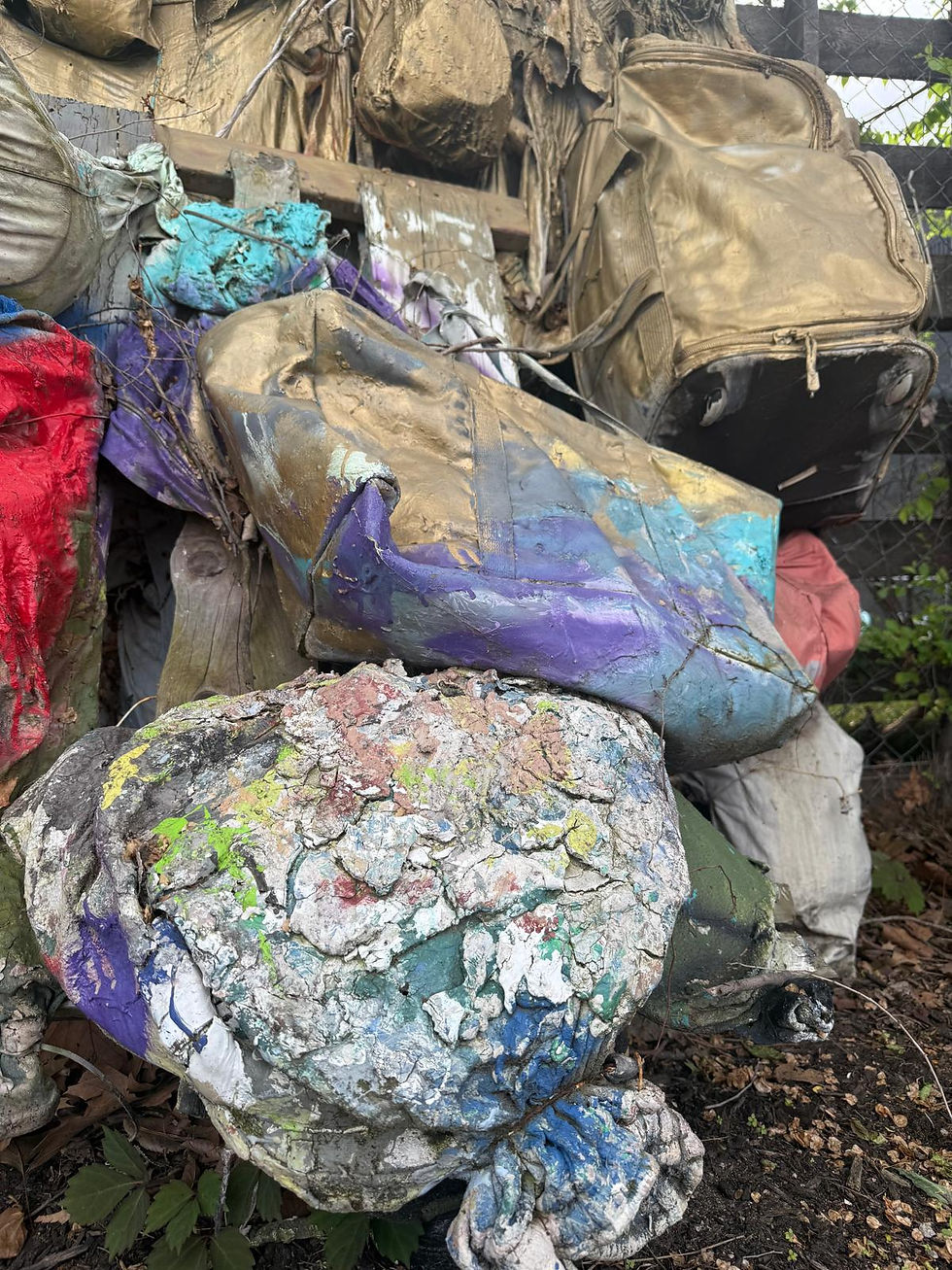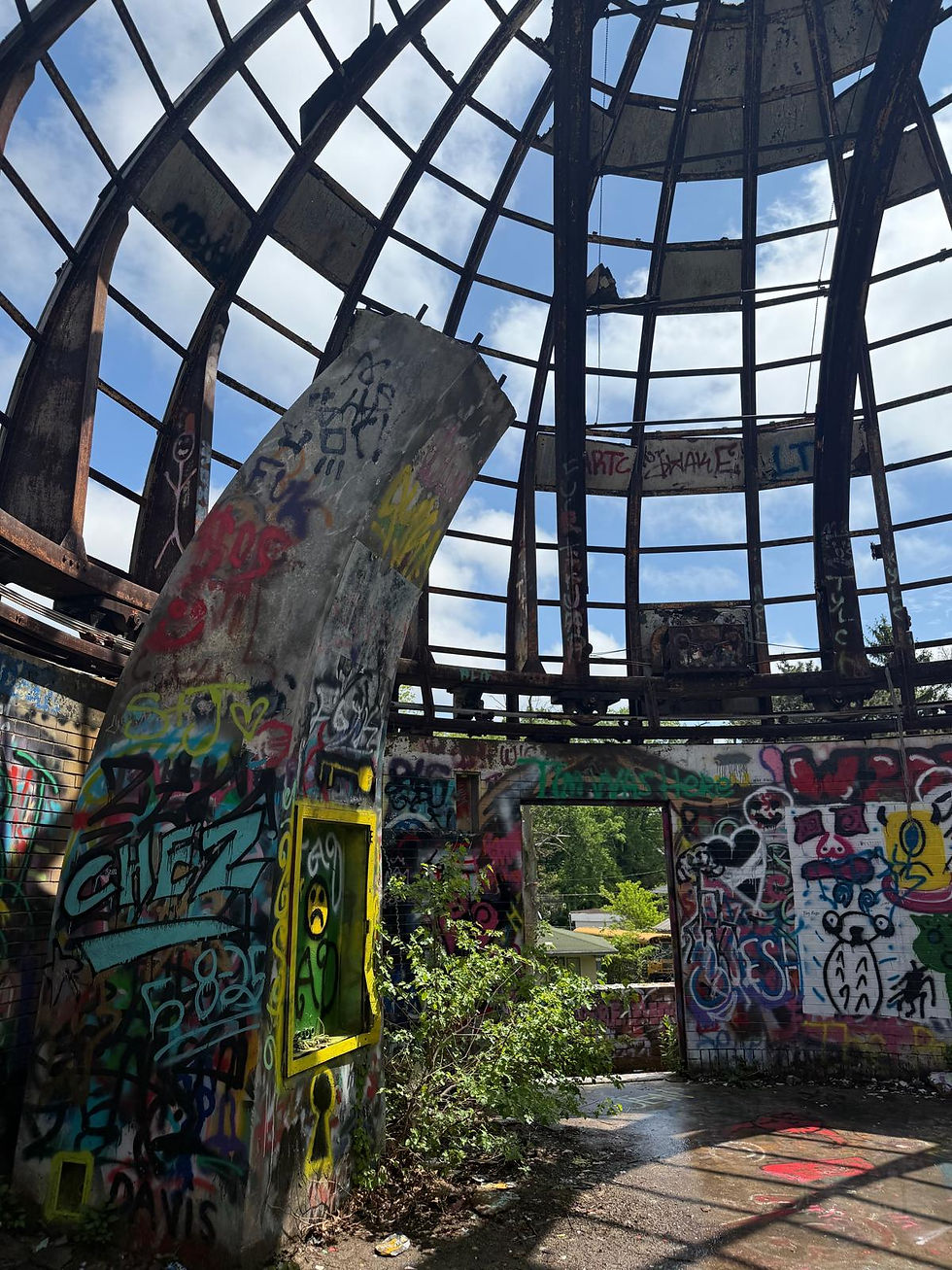SALVAGE
ACCUMULATION
Rustlight
Radiance
THE POSSIBLE IS NOT YET FINISHED
SALVAGE
ACCUMULATION
“The artwork is presented as a social interstice within which new ‘life possibilities’ appear to be possible.”
— Nicholas Bourriard
.jpeg)
.jpeg)
.jpeg)
.jpeg)
Encountering a house on E 55th Street, Slavic Village, Cleveland
The house leans gently into its own undoing. The house does not resist time or nature. Quiet things gather. The story is layered, unfinished and beautiful. The house glows in stillness.
“To notice patterns of unintentional coordination means watching the interplay of temporal rhythms and scales in divergent lifeways.” — Anna Tsing
.jpeg)

.jpeg)

Pockets of Poetry, various locations, Cleveland
From weathered baggage reborn as sculpture to a makeshift shelter beneath the arches of a bridge, this series witnesses Cleveland’s marginal poetry. A faded sign sits among over 40 years of cultural activity at the Edward E. Parker Museum, while a frontyard artist-collector presides over a living collage of memory and imagination. These images capture quiet resonance: moments of expression, adaptation and care in unexpected corners of the city.
Space is a "simultaneity of stories so far".
Place is “throwntogetherness”— a site of multiple, coexisting stories.
— Doreen Massey
.jpeg)

.jpeg)
.jpeg)
Richman Brothers Factory, Cleveland, Ohio
Once part of Cleveland’s manufacturing base, the Richman Brothers Factory now sits abandoned, marked by decay, graffiti and gradual collapse. These images capture the site’s current condition: its interior stripped and tagged, its exterior surrounded by debris and rusted barriers. Generative storytelling from the specific textures, histories and possibilities of place encourages new narratives to emerge from direct, situated observation and community witness.
Space is always open, dynamic and under negotiation.
.jpeg)
.jpeg)
.jpeg)
.jpeg)
Warner & Swasey Building, Cleveland, Ohio
The Warner & Swasey Building, once a precision instrument factory, now sits hollowed but not inactive. These images highlight the value of close observation in abandoned places: moss growing through an abandoned mattress, plants sprouting through floorboards, graffiti layers mapping time in colour. This is a shift into another kind of life. As in ecological systems, something always follows collapse.
Taking cues from studies of possibility and ecological entanglement, we can read sites like this as open-ended. Paying attention to how materials, environments and people still interact here offers a grounded approach to storytelling, one rooted in place, uncertainty and the slow work of emergence.
Decay can be productive. Heritage is a process, not a static object. Post-preservation ethic informs how ephemeral or declining cultural practices are framed: allowing some things to persist with dignity while narrating their significance.
.jpeg)


.jpeg)
Warner & Swasey Observatory, East Cleveland, Ohio
The Warner & Swasey Observatory in East Cleveland once opened its dome to the stars, built in 1920 by the founders of the Warner & Swasey Company, makers of telescopes, precision instruments and industrial tools. A place where science met sky, it housed astronomical research for Case Western Reserve University until the 1980s, when light pollution and institutional shifts left it quiet.
Now, the observatory stands in a different phase of life. Peeling walls echo with a different kind of data: vines map time in slow curls and topographies of fractured plaster and paint are a palimpsest of creative encounter. What once measured celestial motion now plays host to weather, memory and moss.
To look closely here is to witness transformation. The building, though no longer preserved in a traditional sense, participates in an ongoing ecology of erosion, reclamation and residual meaning. As heritage becomes process, not possession, we might ask: what emerges when history is allowed to unravel, breathe and shift?




Chapman & Elderwood, East Cleveland, Ohio
Until recently, the corner of Chapman and Elderwood in East Cleveland stood as a stark portrait of systemic neglect. Entire blocks hollowed out, burned, buckled and problematic. Viral footage in 2023 exposed the extent of collapse: streets of abandoned homes left to rot, raising hard questions about delayed demolitions and failed municipal care.
Now, they’re gone. The homes have been razed. What’s left is not absence, exactly, but aftermath. Concrete dust and churned earth. Saplings pressing through where porches once stood. With the structures erased, what remains is the residue of former lives and the early signs of a new ecology taking root.
Decline has become a shifting field of possibility. When progress is suspended and ruin made visible, other relations emerge. Not the clean slate of redevelopment, not yet, but a terrain shaped by interruption, memory and the return of non-human actors.
Nature moves in where capital stalls. In the interim, weeds archive old floorplans and birds nest where blueprints wait. This isn’t preservation or growth in familiar terms, it's the murky middle, a deep pause between erasure and reinvention.




Fridrich Bicycle, Ohio City
For 141 years, Fridrich Bicycle anchored Lorain Avenue—first a coal-and-feed shop (1883), then Cleveland’s oldest bike store. The lights are off now at 3800 Lorain, pegboards ghosting the outline of wrenches, thick layers of dust settled where tune-ups once queued. Outside, Ohio City turns the corner; inside, what remains is inventory of memory—hand-lettered price tags, counters polished by decades of elbows. The shop did not close with a grand finale so much as a held breath: a storefront at the edge of its working life, recording the slow fade from neighborhood workshop to priced-out dereliction.